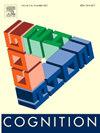Image primitives supporting perception of animate forms
IF 2.8
1区 心理学
Q1 PSYCHOLOGY, EXPERIMENTAL
引用次数: 0
Abstract
The human visual system can recognise familiar forms, most notably faces, in other objects or patterns, a phenomenon known as pareidolia. The patterns that elicit pareidolia range from meaningful to ambiguous and random images, making it hard to generalise across the featural or configurational properties that trigger different types of pareidolia. Here, we aim to characterise the minimal stimuli associated with different types of pareidolia and investigate the extent to which pareidolia is tuned to variations in natural scene statistics and symmetry. Participants in the current study viewed a range of synthetic noise patterns varying in their spatiotemporal spectral and symmetry characteristics and reported any shapes or structure perceived in these patterns. The patterns with spatiotemporal properties typical of natural scenes generated the highest number of responses with more animate, rather than inanimate, forms overall. While faces were the most reported animacy-related percept, responses covered a wide range of animate agents including animals and mythical creatures. The greatest number and the highest proportion of animacy-related percepts were observed in vertically symmetrical patterns compared to other types of pattern symmetry. Together, the current study establishes that pareidolia is tuned to natural scene statistics and biased towards animate forms, especially in patterns with vertical symmetry. It also demonstrates the usefulness of synthetic noise stimuli for pareidolia research.
支持感知动画形式的图像原语
人类的视觉系统可以在其他物体或图案中识别出熟悉的形状,最明显的是面孔,这种现象被称为空想性视错觉。引发幻想性视错觉的模式从有意义的到模糊的和随机的图像,使得很难概括引发不同类型幻想性视错觉的特征或配置属性。在这里,我们的目标是描述与不同类型的空想性视错觉相关的最小刺激,并研究空想性视错觉对自然场景统计和对称性变化的调节程度。在当前的研究中,参与者观察了一系列在时空光谱和对称特征上变化的合成噪声模式,并报告了在这些模式中感知到的任何形状或结构。具有典型自然场景时空特性的模式产生的响应数量最多,总体上有生命的形式多于无生命的形式。虽然脸是最常见的与动物相关的感知,但反应涵盖了广泛的动物和神话生物。与其他类型的对称图案相比,在垂直对称图案中观察到的动物相关感知的数量和比例最高。总之,目前的研究表明,幻想性视错觉倾向于自然场景统计,并偏向于动画形式,特别是垂直对称的模式。它还证明了合成噪声刺激对空想性视错觉研究的有用性。
本文章由计算机程序翻译,如有差异,请以英文原文为准。
求助全文
约1分钟内获得全文
求助全文
来源期刊

Cognition
PSYCHOLOGY, EXPERIMENTAL-
CiteScore
6.40
自引率
5.90%
发文量
283
期刊介绍:
Cognition is an international journal that publishes theoretical and experimental papers on the study of the mind. It covers a wide variety of subjects concerning all the different aspects of cognition, ranging from biological and experimental studies to formal analysis. Contributions from the fields of psychology, neuroscience, linguistics, computer science, mathematics, ethology and philosophy are welcome in this journal provided that they have some bearing on the functioning of the mind. In addition, the journal serves as a forum for discussion of social and political aspects of cognitive science.
 求助内容:
求助内容: 应助结果提醒方式:
应助结果提醒方式:


